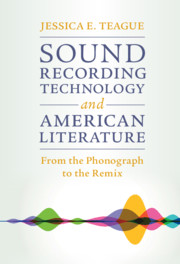Book contents
- Sound Recording Technology and American Literature
- Cambridge studies in American Literature and Culture
- Sound Recording Technology and American Literature
- Copyright page
- Dedication
- Contents
- Figures
- Acknowledgments
- Introduction Resonant Reading
- Chapter 1 Ears Taut to Hear
- Chapter 2 Ethnographic Transcription and the Jazz Auto/Biography
- Chapter 3 Press Play
- Chapter 4 The Stereophonic Poetics ofLangston Hughes and Amiri Baraka
- Chapter 5 From Cut-up to Mashup
- A Post-Electric Postscript Recording and Remix Onstage
- Notes
- Works Cited
- Index
- Recent Books In This Series (continued from page ii)
Chapter 3 - Press Play
Jack Kerouac, William S. Burroughs, and the Tape Recorder
Published online by Cambridge University Press: 07 May 2021
- Sound Recording Technology and American Literature
- Cambridge studies in American Literature and Culture
- Sound Recording Technology and American Literature
- Copyright page
- Dedication
- Contents
- Figures
- Acknowledgments
- Introduction Resonant Reading
- Chapter 1 Ears Taut to Hear
- Chapter 2 Ethnographic Transcription and the Jazz Auto/Biography
- Chapter 3 Press Play
- Chapter 4 The Stereophonic Poetics ofLangston Hughes and Amiri Baraka
- Chapter 5 From Cut-up to Mashup
- A Post-Electric Postscript Recording and Remix Onstage
- Notes
- Works Cited
- Index
- Recent Books In This Series (continued from page ii)
Summary
My third chapter investigates the use of tape recording as a mode of composition for late-modernists Jack Kerouac (Visions of Cody) and William S. Burroughs (The Ticket That Exploded). For Kerouac, the impulse was toward improvisatory transcription, but for Burroughs, tape was an integral part of his notorious “cut-up method.” I focus on the emergence of commercially available tape recording technologies in the 1950s and 1960s, which enabled amateurs to record as well as edit, loop, and manipulate recordings in other imaginative ways. In both novels that I explore, tapes play a key role within the plot; but they were also employed in the construction of the texts. As friends and collaborators with largely different approaches to tape, Kerouac and Burroughs demonstrate how the transformation of agency from consumer to producer of recordings shifted the ways writers imagined their literary projects.
Keywords
- Type
- Chapter
- Information
- Sound Recording Technology and American LiteratureFrom the Phonograph to the Remix, pp. 93 - 127Publisher: Cambridge University PressPrint publication year: 2021

